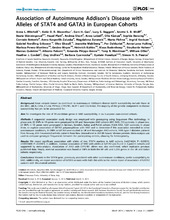| dc.contributor.author | Mitchell, Anna L. | en_US |
| dc.contributor.author | Macarthur, Katie D.R. | en_US |
| dc.contributor.author | Gan, Earn H. | en_US |
| dc.contributor.author | Baggott, Lucy E. | en_US |
| dc.contributor.author | Wolff, Anette Susanne Bøe | en_US |
| dc.contributor.author | Skinningsrud, Beate | en_US |
| dc.contributor.author | Platt, Hazel | en_US |
| dc.contributor.author | Short, Andrea | en_US |
| dc.contributor.author | Lobell, Anna | en_US |
| dc.contributor.author | Kämpe, Olle | en_US |
| dc.contributor.author | Bensing, Sophie | en_US |
| dc.contributor.author | Betterle, Corrado | en_US |
| dc.contributor.author | Kasperlik-Zaluska, Anna | en_US |
| dc.contributor.author | Zurawek, Magdalena | en_US |
| dc.contributor.author | Fichna, Marta | en_US |
| dc.contributor.author | Kockum, Ingrid | en_US |
| dc.contributor.author | Eriksson, Gabriel Nordling | en_US |
| dc.contributor.author | Ekwall, Olov | en_US |
| dc.contributor.author | Wahlberg, Jeanette | en_US |
| dc.contributor.author | Dahlqvist, Per | en_US |
| dc.contributor.author | Hulting, Anna-Lena | en_US |
| dc.contributor.author | Penna-Martinez, Marissa | en_US |
| dc.contributor.author | Meyer, Gesine | en_US |
| dc.contributor.author | Kahles, Heinrich | en_US |
| dc.contributor.author | Badenhoop, Klaus | en_US |
| dc.contributor.author | Hahner, Stefanie | en_US |
| dc.contributor.author | Quinkler, Marcus | en_US |
| dc.contributor.author | Falorni, Alberto | en_US |
| dc.contributor.author | Phipps-Green, Amanda | en_US |
| dc.contributor.author | Merriman, Tony R. | en_US |
| dc.contributor.author | Ollier, William | en_US |
| dc.contributor.author | Cordell, Heather J. | en_US |
| dc.contributor.author | Undlien, Dag Erik | en_US |
| dc.contributor.author | Czarnocka, Barbara | en_US |
| dc.contributor.author | Husebye, Eystein Sverre | en_US |
| dc.contributor.author | Pearce, Simon H.S. | en_US |
| dc.date.accessioned | 2015-03-18T13:24:15Z | |
| dc.date.available | 2015-03-18T13:24:15Z | |
| dc.date.issued | 2014-03-10 | eng |
| dc.identifier.issn | 1932-6203 | |
| dc.identifier.uri | https://hdl.handle.net/1956/9582 | |
| dc.description.abstract | Background: Gene variants known to contribute to Autoimmune Addison's disease (AAD) susceptibility include those at the MHC, MICA, CIITA, CTLA4, PTPN22, CYP27B1, NLRP-1 and CD274 loci. The majority of the genetic component to disease susceptibility has yet to be accounted for. Aim: To investigate the role of 19 candidate genes in AAD susceptibility in six European case-control cohorts. Methods: A sequential association study design was employed with genotyping using Sequenom iPlex technology. In phase one, 85 SNPs in 19 genes were genotyped in UK and Norwegian AAD cohorts (691 AAD, 715 controls). In phase two, 21 SNPs in 11 genes were genotyped in German, Swedish, Italian and Polish cohorts (1264 AAD, 1221 controls). In phase three, to explore association of GATA3 polymorphisms with AAD and to determine if this association extended to other autoimmune conditions, 15 SNPs in GATA3 were studied in UK and Norwegian AAD cohorts, 1195 type 1 diabetes patients from Norway, 650 rheumatoid arthritis patients from New Zealand and in 283 UK Graves' disease patients. Meta-analysis was used to compare genotype frequencies between the participating centres, allowing for heterogeneity. Results: We report significant association with alleles of two STAT4 markers in AAD cohorts (rs4274624: P = 0.00016; rs10931481: P = 0.0007). In addition, nominal association of AAD with alleles at GATA3 was found in 3 patient cohorts and supported by meta-analysis. Association of AAD with CYP27B1 alleles was also confirmed, which replicates previous published data. Finally, nominal association was found at SNPs in both the NF-κB1 and IL23A genes in the UK and Italian cohorts respectively. Conclusions: Variants in the STAT4 gene, previously associated with other autoimmune conditions, confer susceptibility to AAD. Additionally, we report association of GATA3 variants with AAD: this adds to the recent report of association of GATA3 variants with rheumatoid arthritis. | en_US |
| dc.language.iso | eng | eng |
| dc.publisher | Public Library of Science | eng |
| dc.rights | Attribution CC BY | eng |
| dc.rights.uri | http://creativecommons.org/licenses/by/4.0/ | eng |
| dc.title | Association of autoimmune Addison's disease with alleles of STAT4 and GATA3 in European Cohorts | en_US |
| dc.type | Peer reviewed | |
| dc.type | Journal article | |
| dc.date.updated | 2015-03-03T16:24:34Z | en_US |
| dc.description.version | publishedVersion | en_US |
| dc.rights.holder | Copyright 2014 Mitchell et al. This is an open-access article distributed under the terms of the Creative Commons Attribution License, which permits unrestricted use, distribution, and reproduction in any medium, provided the original author and source are credited. | |
| dc.source.articlenumber | e88991 | |
| dc.identifier.doi | https://doi.org/10.1371/journal.pone.0088991 | |
| dc.identifier.cristin | 1150520 | |
| dc.source.journal | PLoS ONE | |
| dc.source.40 | 9 | |
| dc.source.14 | 3 | |
| dc.subject.nsi | VDP::Medical sciences: 700::Basic medical, dental and veterinary sciences: 710::Medical genetics: 714 | eng |
| dc.subject.nsi | VDP::Medisinske fag: 700::Basale medisinske, odontologiske og veterinærmedisinske fag: 710::Medisinsk genetikk: 714 | nob |

